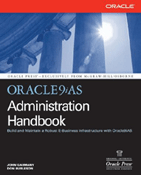Inside the Oracle App Server Infrastructure Repository
As the scope of Oracle9iAS expanded, Oracle recognized that a centralized data repository was required to handle all of the metadata required by Oracle9iAS. This need was achieved by creating an Oracle database on the Oracle9iAS mid tier called Isadb. The metadata repository is known by several names, including the Oracle9iAS infrastructure repository, the infrastructure instance, and Isadb. The Isadb name is the default $ORACLE_SID for the Oracle9i database that hold the data.
The metadata repository holds configuration for many of the Oracle9iAS components, and is also extended for use by SSO. As of release 9.0.4, there are nearly 20 Oracle9iAS components, and many of these use iasdb for centralized metadata storage. Also, starting in release 9.0.4, the infrastructure may be any supported release of Oracle9i that is at the correct version and patch level.
Remember, not all Oracle9iAS components make the same use of Isadb. For example, OID and SSO uses Isadb to store security access data, while other components such as OHS and Web Cache store only configuration information in Isadb.
The core of the infrastructure is the Oracle Iasdb instance. This database contains all of the metadata and internal information for all SSO components, Oracle Portal, Oracle wireless and some DCM components. The infrastructure repository holds data for all Oracle9iAS components in a Farm, and is critical to the proper operation of these components:
- OID — Oracle Internet Directory (LDAP)
- DCM — The Distributed Configuration Manager
- Portal — The web development component of Oracle9iAS
- OEM — The repository for many OEM components
- SSO — Oracle single Sign-on
- Wireless — Oracle wireless metadata
Let’s begin with a quick tour of the Iasdb database and examine the various schemas within this database and see how each schema is used by the Oracle9iAS components. We will also examine the Iasdb log files and look at queries that can be automated for easy viewing.
The Iasdb database instance has many individual schemas. Each of these schemas has a special function to help control and manager each of the various Oracle9iAS components. The list of the Oracle9iAS schemas within Iasdb is shown in Table 2.1. Please note that these schema components are always installed in the Infrastructure database, even if you are not using a component.
| AURORA$JIS$UTILITY$ | Oracle Servlet Engine schema |
| AURORA$ORB$UNAUTHENTICATED | Oracle Servlet Engine schema |
| DCM | Distributed Configuration Manager |
| DISCOVERER5 | Oracle9iAS Discoverer |
| DSGATEWAY | Oracle9i Syndication Server |
| INTERNET_APPSERVER_REGISTRY | Contain the COMPONENTS table |
| IP | TCP/IP replication (advanced queuing) and Internet audit log tables |
| OCA | Oracle9iAS certificate Authority |
| ODS | Oracle Internet Directory metadata |
| ORAOCA_PUBLIC | Oracle9iAS certificate Authority synonyms |
| ORASSO | Oracle9iAS Single Sign-On |
| ORDSYS | Oracle InterMedia Audio schema |
| ORDPLUGINS | Oracle InterMedia Audio schema |
| OSE$HTTP$ADMIN | Oracle Servlet Engine |
| OWA_MGR | Oracle Workflow |
| PORTAL | Oracle9iAS Portal |
| PORTAL_APP | Oracle9iAS Portal |
| PORTAL_DEMO |
Oracle9iAS Portal demonstration schema |
| PORTAL_PUBLIC | Oracle9iAS Portal Public synonyms |
| UDDISYS | Oracle9iAS Web Services |
| WFADMIN | Oracle workflow |
| WIRELESS | Oracle9iAS Wireless |
| WKSYS | Oracle Ultra Search |
| WK_PROXY | Oracle Ultra Search |
| WK_TEST | Oracle Ultra Search |
Table 2.1: The Iasdb schema components.
Once we understand the schema owner’s purpose, we can dive down and examine the complexity of each schema. As the Oracle9iAS administrator you must become intimate with these schemas and understand which schemas control what system functions. The Iasdb instance has schemas that must be locked, other schemas whose password may be changed at will, and schemas that are registered with the OID and should only be changed using OEM.
Immutable Iasdb Schemas
Some of the schema components are immutable and the passwords and data structures must never be changed. This is especially true for this group of Iasdb schema:
| Schema Name | Used By | Default Password |
| CTXSYS | Intermedia Text option | change_on_install |
| MDSYS | Spatial Data option | mdsys |
| OLAPDBA | OLAP Services option | olapdba |
| OLAPSVR | OLAP Services option | instance |
| OLAPSYS | OLAP Services option | manager |
| ORDPLUGINS | InterMedia Audio option | ordplugins |
| ORDSYS | InterMedia Audio option | ordsys |
| OUTLN | Stored Outlines | outln |
Workflow Iasdb Schemas
The following Iasdb schemas are used by the Oracle workflow component and the passwords may be changed as desired:
| Schema Name | Used By | Default Password |
| BLEWIS Workflow | component | blewis |
| CDOUGLAS Workflow | component | cdouglas |
| KWALKER Workflow | component | kwalker |
| SPIERSON Workflow | component | spierson |
---
 |
The above text is an excerpt from the Oracle Application Server 10g Administration Handbook Check out the whole series of exciting new Oracle10g books at http://www.oraclepress.com/cgi-bin/oraclepress/ |
John Garmany is a leading expert in Oracle Application Server Consulting and Support. He specializes in Oracle9iAS and Oracle Application Server 10g configuring and tuning.
Donald K. Burleson has been a working DBA for more than 20 years and specializes in creating large-scale, web-enabled Oracle Database systems.
Contributors : Donald K. Burleson, John Garmany
Last modified 2005-06-22 12:41 AM
